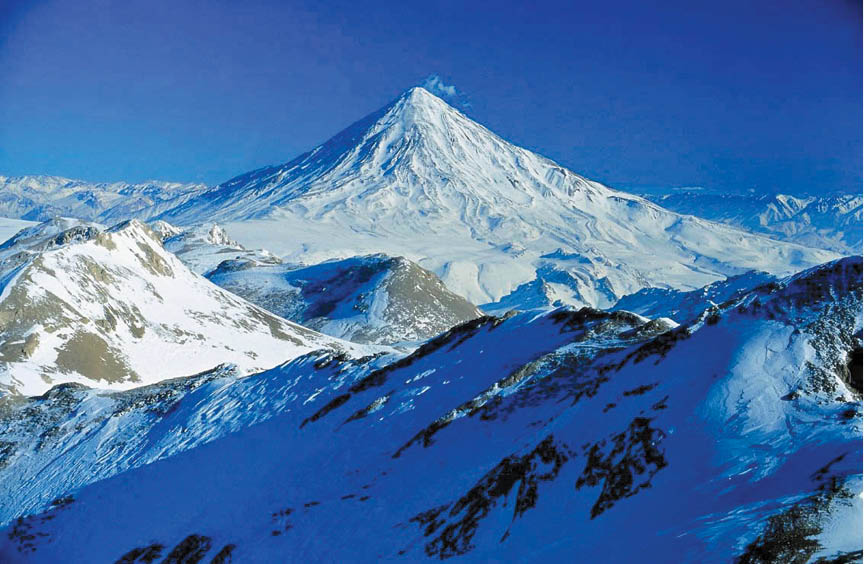Since ancient times, mountains have held a place of special reverence in Zoroastrian lore. There is nothing pagan about this belief, because all devout Zoroastrians have been enjoined with a sacred duty to look after, respect and revere all the good creations of Ahura Mazda. In the prayer pertaining to homage unto mountains, we pray:
“Az hama gunah patet pashemanum
Vispao garayo asha-khvathrao pouru-khvathrao mazdadhata ashavana ashahe ratavo yazamaide.”
“Of all sins, I repent with patet. We praise all holy mountains created by Hormazd (which are) fully comfortable (spacious and with goodness and fulness) full of welfare (spiritual and material) (and) useful things of righteousness (grow there).”
In other words, mountains are seen as spiritual strongholds that represent strength and emanate positive energy. In esoteric circles, mountains signify, among other things, “cosmic or spiritual consciousness”. It is little wonder that Asho Zarathushtra lived for ten years on Mount Ushidarena contemplating the Truth of this universe.
In Karda VIII of “Sarosh Yasht Vadi“, we pray:
“Sraoshem ashim huraodhem verethrajanem, fradat-gaethem ashavanem ashahe ratum yazamaide. Yim yazata Haomo Frashmish baeshazyo, sriro, khshathrayo, zairi-doithro, barezishte paiti barezahi Haraithyo paiti Berezayao.”
Translated as:
“We worship the righteous and Holy Sarosh (yazata), beautiful, victorious, bringing-prosperity to the world, (and) the Lord of righteousness; whom Haomo, prosperity-bringer, healing, beautiful, kingly (and)
golden-eyed worshipped upon the highest peak of the Mount Albourz.”
According to ‘Vendidad’-19.30, “The soul of the pious proceeds by way of Albourz, crossing the Chinwad bridge.” According to the Pahlavi ‘Dadastan-e-Menok Khrat’, Albourz is all around the world and the star Vanant guards the gates of the Mount Albourz, so that demons and other evil spirits may not be able to block the path of the sun, the moon and the stars. The reference to Albourz in our holy scriptures, apparently, is not to any earthly mountain or mountain range, but a cosmic, spiritual creation of Dadar Hormazd.
However, there is also an earthly mountain range by the name of Albourz, in northern Iran, which runs from Tabriz to the Caspian coast and all along the north to Khorasan. This range fuses with the Hindukush and Himalayan ranges in Afghanistan and India. The highest peak in the Albourz range is Mount Damavand. With a high point of 5610.27 meters, Damavand is the highest mountain peak in Iran located almost in the center of Alborz mountain range. Damavand is higher than all west Asian and European mountain peaks. Damavand peak is situated in Larijan district, southwest of Amol and 69 kilometers northeast of Tehran.
The slopes and skirts of this mountain are filled with volcanic lava and sulfur gases flow out of many volcanic mouths of this peak. The lava and other volcanic substances have been piled in layers on a sediment base composed of the stones belonging to the first and second eras.
Damavand mountain is the epicenter of an earthquake belt which stretches along Mazandaran province and many spas containing various substances flow out of it. Such spas include, Ask, Talkh Roud and Larijan. All springs flowing from Damavand mountain pour into Haraz river. To devout Zoroastrians, Mount Damavand is as sacred as Mount Kailash is to devout Hindus and Mount Fujiyama is to the Japanese.
According to legend, King Faridoon of the Peshdadian dynasty, with his spiritual powers, had imprisoned Azhi Dahaka or Zohak (the personification of evil) to this sacred mountain. They say by night (when the forces of darkness and evil gain more strength) Azhi Dahaka’s allegorical chains begin to weaken and melt but, at the crack of dawn, when the cock crows ushering the forces of light and purity, the chains, once again, bind the demon securely. This is a great Truth in Nature, brilliantly expressed in allegorical form.
There is yet another story from Peshdadian times. The evil Afrasiyab had attacked Iran but had not succeeded in conquering her, so he made a treaty with King Minocheher. The condition of the treaty was that the boundaries of King Minocheher’s kingdom would be determined by the distance an arrow (Persian: tir) could be shot. The wise among the people in Iran made a special arrow with great skill and craftsmanship. That tir (arrow) was shot by a skilled and powerful archer named Aresh, from Mount Damavand. Aresh shot the tir eastward, and it soared across the country for 12 hours and fell near the Jehun sea. Afrasiyab then retreated to that place and the territorial boundary between Iran and Turan was thus established. This event is believed to have occurred on the day Tir of the month Tir and a great jashan was held on that day.
While concluding, may we invoke the eight verse of the Pazand prayer, “Afreen-i-haft Ameshaspandan“:
“Hama-zor Daemavand koh ke dravand Bivarasp andar oye basta ested.”
Or, “Be in accord (or attuned) with Daemavand Koh (mountain) in which is enchained the demon Bivarasp, the demon (with power) of ten thousand horses.” This means attune yourself with this great spiritual mountain which has the power to bind all forces of evil and keep this world safe from the onslaught of the demon Bivarasp!
- The Feast Of Tirgan - 23 November2024
- Life And Message Of Asho Zarathushtra – II - 16 November2024
- Life And Message Of Asho Zarathushtra –I - 9 November2024
